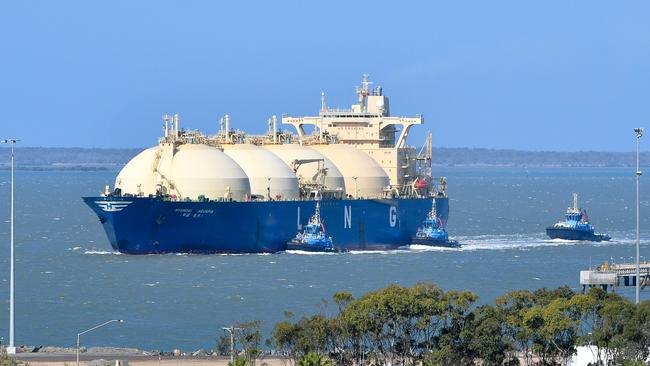Gas fuels budgets except in places they prefer hot air

First, we learned from the chief economist at the Department of Industry, Science and Resources that Australia’s global reputation as a reliable exporter goes from strength to strength. There was a record $70bn of LNG exports last financial year, up from $30bn, and exports are forecast to hit more than $84bn in 2022-23.
Second, the bottom-line community benefit of this was shown in the recent Queensland budget. While the state’s gas sector recently stepped up to meet massive energy demand spikes caused by widespread coal outages during east coast energy system pressures, the state’s budget also delivered another stunning reminder of the importance of the Gladstone LNG export hub.
Queensland petroleum royalties will more than double over the next five years – from $2.7bn forecast last year to $5.9bn forecast this year – amazing numbers for an industry created just over a decade ago. In fact, it wasn’t until 2014-15 that petroleum royalties got their own line in the budget papers. Now that line is worth almost $6bn, the equivalent of providing healthcare for more than 150,000 people annually or building 60 new schools.
It is a big bang for Queensland’s buck after more than a decade of investment and support for onshore gas development.
It’s a similar story in Western Australia, where gas accounted for about $1bn paid to government coffers last financial year, and the Northern Territory, where its budget revealed its economic growth was being powered by gas in the Top End.
The no-nonsense northern states have got on with the job while southeastern states have stifled their economies with nonsensical bans. NSW has substantial gas resources but its Treasurer, Matt Kean, had no petroleum royalties in his budget on the same day as Queensland delivered its blueprint. And despite having the most gas users in the country, Victoria has discouraged local investment by announcing a plan to cut it off – without a plan to replace it.
Victoria would rather have Queensland break export contracts with key Asian countries than develop its own supply.
Critically, it is only if we honour our contracts and remain a reliable partner will these countries become future investors and customers needed to develop an Australian hydrogen industry.
The export results highlight the importance of maintaining the investment policy settings that have made exports critical to Australia’s economy and global reputation in a cleaner energy future. Erroneous claims about exports causing east coast price pressures were destroyed by EnergyQuest research instead identifying the cause as the rapid demand for gas-powered generation when coal and renewables faltered.
Australia is an export economy and is fortunate to have generated great wealth from exports such as wool, beef and wine. All of these industries supply the domestic market as well but when was the last time you heard someone call for wine exports to be diverted to domestic supply?
As a world-leading exporter of LNG, rivalled only by Qatar and the US, we can thank the LNG export jurisdictions of WA, the NT and Queensland for their future planning. In Queensland, it was the size of the LNG export industry that provided the economies of scale needed to develop the state’s natural gas industry to the size it is today. And that has meant Queensland now has the capacity to supply the domestic market – including NSW and Victoria when, as occurred recently, coal-powered stations suffer outages and renewables output is affected by bad weather.
It’s sometimes forgotten that in the early 2000s the plan for gas in Queensland was to build a pipeline to supply gas all the way from Papua New Guinea. Australia’s east coast energy security would have been reliant on imports, and the jobs and royalties would be overseas too.
Natural gas will also be a future fuel as we help state and federal governments meet their climate targets and meet our commitment to net-zero greenhouse gas emissions by 2050.
People are often surprised to hear it but the gas industry supports renewable growth because, as we’ve seen recently, gas is an essential stabiliser to renewables. Our industry is one of the biggest investors in and most prepared to tackle the technical challenges of reducing emissions. About $6bn in initiatives have already been announced for technology, such as carbon capture and storage.
CCS is a proven emissions reduction technology used for decades and won’t just lower emissions from our operations. It enables clean hydrogen to be made from natural gas and delivered to the market faster and more affordably than other forms of hydrogen. It’s another area Australia can capitalise on with basins supplying gas being identified as having high prospectivity and potential for CO2 storage.
But our gas exports can also help change the world. We often hear in climate change debates that Australia is only a small part of the world and can’t help beyond symbolic gestures. This is incorrect. With reducing emissions in Asia a core global challenge to get to net zero, it is critical to help these countries replace dirtier coal, improve air quality and lift living standards for hundreds of millions of people who use dirty fuels for cooking.
There is growing demand in these countries for our gas and the Australian government has estimated our LNG has the potential to lower emissions in LNG-importing countries by about 166 million tonnes of carbon dioxide each year, by replacing higher-emissions fuels. That is equivalent to more than a third of Australia’s total annual greenhouse gas emissions.
Our gas export industry isn’t just of value to Australia. It is valuable to the world.
Damian Dwyer is the acting chief executive of the Australian Petroleum Production and Exploration Association.



Two recent announcements highlighting the importance of liquefied natural gas to Australia should have given cause for a rethink to those behind irresponsible calls to intervene in our gas export market.